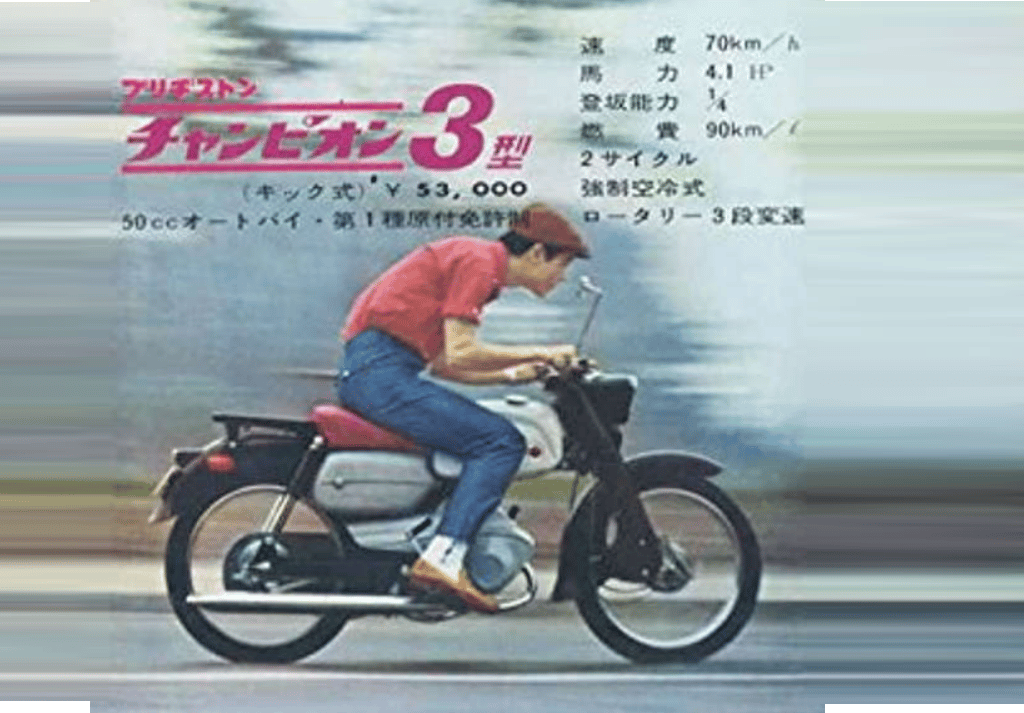Bridgestone: A Journey from Mopeds to Premier Tires
The article takes a look at the history of Bridgestone, a tire and rubber company that started as a bicycle manufacturer during post-war Japan's need for affordable private transportation. Bridgestone eventually transitioned to producing power-assisted bicycles, mopeds, and motorcycles, distinguished by their advanced two-stroke engines. In 1970, Bridgestone shifted its focus to tire production, using their experience in motorcycle manufacturing to gain a profound understanding of the demands and specifications required for top-tier tires. Today, Bridgestone is the world's largest tire and rubber company, committed to producing top-notch products and sustainability.
MOTORCYCLES VINTAGE MOPEDS1960'SJAPAN BRIDGESTONE
11/1/20233 min read


Bridgestone: A Journey from Mopeds to Premier Tires
Let's take a thrilling ride through the intriguing history of Bridgestone, a name that not only resonates in the tire industry but also has deep-rooted ties to the world of motorcycles. In 1945, Soichiro Ishibashi laid the foundation for what would become a tire and motorcycle legend, inspired by his own name's English translation - 'Ishi' meaning 'stone' and 'Bashi' meaning 'bridge.' While Ishibashi initially delved into automotive parts through his trading company, it was the post-war demand for affordable private transportation in Japan that ignited his passion for bicycle manufacturing.
But Bridgestone's story doesn't stop there. In 1952, the company ventured into producing power-assisted bicycles, a modest beginning that would later evolve into mopeds and ultimately, motorcycles. Bridgestone's motorcycles, distinguished by their advanced two-stroke engines, set a new standard in the industry. This innovation, while raising prices, also elevated the brand's reputation, firmly establishing it in the world of two-wheelers.
Bridgestone Motorcycles and Mopeds
The journey into the realm of powered two-wheelers began with Bridgestone's introduction of bicycles equipped with auxiliary engines. These "slip-on" power units, initially supplied by Fuji Seimitsu Jogyo (now a part of Nissan Motor Co.), were first sold separately. However, in 1952, Bridgestone unveiled its first complete motorized cycle, the BS-21 'Bambi.' This remarkable machine featured a 26cc two-stroke engine mounted over the rear wheel of a standard BS bicycle, providing power through friction drive onto the rear tire. Subsequent models, such as the BS-31 and BS-41, came equipped with 38.5cc and 49cc engines, respectively.
In 1958, Bridgestone introduced its first iconic motorcycle, the 'BS Champion.' Each step in this journey solidified Bridgestone's reputation in the world of two-wheelers, making them a prominent player in the Japanese motorcycle market.
Transitioning from Motorcycles to Tire Manufacturing
In 1970, Bridgestone made a pivotal decision to cease motorcycle production. This strategic move was aimed at ensuring a steady supply of tires to other manufacturers. It marked a significant shift in Bridgestone's journey, as the company transitioned from being a motorcycle manufacturer to a tire production powerhouse. While Bridgestone had been involved in tire production from its inception, this change in focus laid the foundation for their eventual rise to prominence in the global tire industry.
What's fascinating is that Bridgestone's background in motorcycle manufacturing played a pivotal role in their success as a tire producer. Building motorcycles allowed them to gain firsthand experience and a profound understanding of the demands and specifications required for top-tier tires. This valuable experience contributed significantly to their transformation.
Bridgestone as a Premier Tire Manufacturer
Today, Bridgestone stands as the world's largest tire and rubber company, expanding its reach into the Americas with over 50 production facilities and a dedicated workforce of more than 55,000 employees. Their acquisition of The Firestone Tire & Rubber Company in 1988, founded by Harvey Firestone, marked a significant turning point in Bridgestone's journey, propelling them to the forefront of the tire industry on a global scale.
Bridgestone's commitment to producing top-notch products and their dedication to sustainability are evident in their everyday operations. Their environmental mission underscores their responsibility in creating a healthier environment for future generations, a testament to their unwavering commitment to serving society with superior quality, as expressed by founder Shojiro Ishibashi.
In the end, Bridgestone's transition from motorcycle production to becoming a global tire industry leader is a testament to their relentless pursuit of quality, innovation, and excellence. It's a journey that reminds us that experience and dedication can transform a company into a world-class leader. Bridgestone's story is one of evolution, from motorcycles to premier tires, and it's a testament to their unwavering commitment to excellence.
